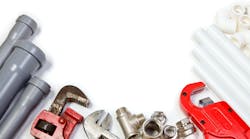Whether you are a service oriented shop, a new construction shop or a hybrid of both, buying, storing and/or stocking material is an important part of your everyday operation. On the one hand, if you have a good relationship with a supplier, they can make your job easier and smoother. On the other hand, if you, like so many contractors today, are constantly shopping for that “nickel less per stop” or “two cents less a foot” for copper tube, pitting one supply house against another for whatever leverage you can get, you'll have to work a little harder at establishing and keeping your stock inventory in good shape.
The first question is, do you stock material or order by the job? A good service shop really needs a good inventory of the parts its journeymen use on a regular basis. Now that can mean stocking a service truck, or trucks, directly from a supply house or from stock on hand at the shop. In either case, keeping a good stock of material on hand at all times is a must. A new construction shop can stock projects in phases or have the material for the entire project delivered to the site to be used “as needed.” Let's take a look.
Service inventory
In this example let's take a service shop that runs three trucks, plus they have a showroom with kitchen and bath displays. Stocking material directly from a supplier would add an extra level of difficulty for the company and also limit point of purchase sales of fixtures and accessories. Having and keeping an inventory on hand is the obvious solution. Keeping a large amount of faucets, fixtures and accessories on hand is not required to have a viable stock for sale. Think one or two of each major fixture and multiples of the accessories based upon sales records. Maintaining the stock on service trucks is relatively straight forward as well, if you have set it up properly.
With the advent of Q-readers and Bar Code Scanners built in to mobile phone apps, it is a simple matter to keep track of material as it is consumed or sold.
Today, the digital revolution has made inventory control a simple thing. With the advent of Q-readers and Bar Code Scanners built in to mobile phone apps, it is a simple matter to keep track of material as it is consumed or sold. As an example, truck No.1 does a service call and replaces a kitchen sink faucet. Material used consists of a new faucet, two supply tubes, putty, teflon paste or other shop supplies (quantified in a lump sum). When the journeyman writes the bill, he scans the bar code of each item, which will provide him with the resale price of the material and enter it on the print out of the bill, while simultaneously deducting the items from your stock database and, if you are really on the ball, reordering it.
When that truck returns to the shop that day you, or your designated shop manager, will have a box/bag of all the material taken out of stock for that vehicle, that day, ready to be restocked. As well, the material will either be deducted from on hand supplies or reordered depending upon your preference. In this way, your trucks and warehouse are kept fully stocked and ready for business. Admittedly, it does take some effort to get a system like this set up, but once you have invested the time, the rewards are worth it. This, as opposed to showing up at a job and needing a simple part and not having it. That is a lose-lose proposition for your business.
New construction inventory
Ordering material for new construction projects is, somewhat, easier than for a service shop. The criteria would be something along the lines of whichever supplier you are using is provided with a copy of the job takeoff. If the project is broken down by phases, the material is ordered accordingly. Easy, right? Suppose, however, you are doing multi-family housing or tract housing work. What is the most efficient way to order, control and consume material? There are as many ways to answer that question as there are different shops, so let me give you my take.
First and foremost an accurate material take off is a must! It should be broken down by building, unit(s) and phases.
First and foremost an accurate material take off is a must! It should be broken down by building, unit(s) and phases. Whether you are doing commercial/industrial or tract work the method is still the same. If you are working with one specific supplier, you can coordinate with them for delivery based upon the takeoff and the projected time line as provided by the contractor or architect. It may be better for you to have a yard or storage facility to keep the material secure rather than have it delivered to a wide open jobsite. The downside of that is you will have to move the material to the site on an as needed basis.
Once you have established which method you will use, whether drop shipped to the site in stages or delivered to your yard or shop, you will need to set up a job account. This way only designated people can purchase material (if needed) for that particular project or phase of that project. This precaution will make it easier to keep track of incidental purchases related to the job. With the supplier's knowledge and agreement, if material is purchased by other than those properly designated, you are not responsible for paying for it. Having seen material purchased on job accounts for “side jobs” by journeymen and others, I know whereof I speak. Material control is critical to business success. Being lax or off hand will not do.
The Brooklyn, N.Y.-born author is a retired third generation master plumber. He founded Sunflower Plumbing & Heating in Shirley, N.Y., in 1975 and A Professional Commercial Plumbing Inc. in Phoenix in 1980. He holds residential, commercial, industrial and solar plumbing licenses and is certified in welding, clean rooms, polypropylene gas fusion and medical gas piping. He can be reached at [email protected].


